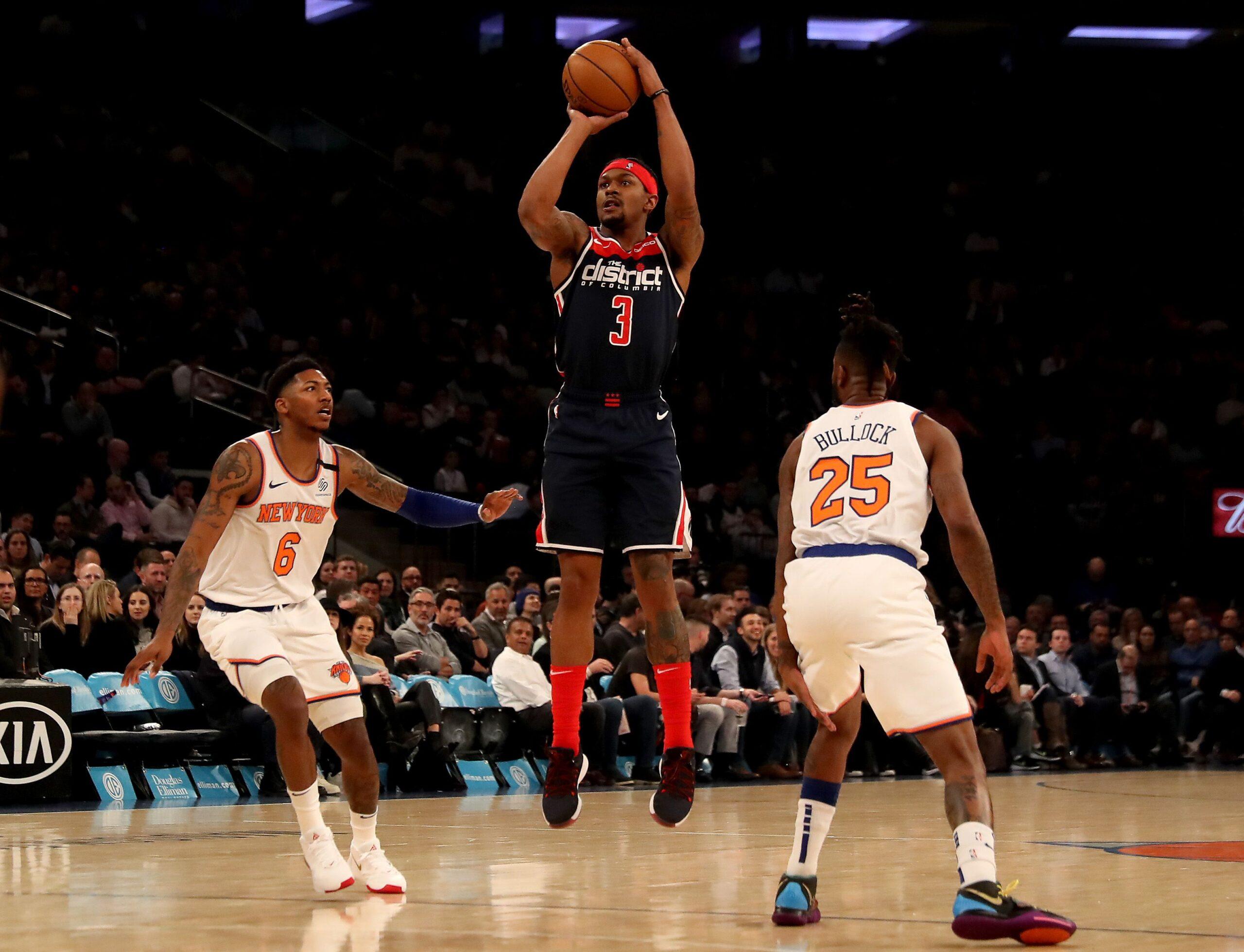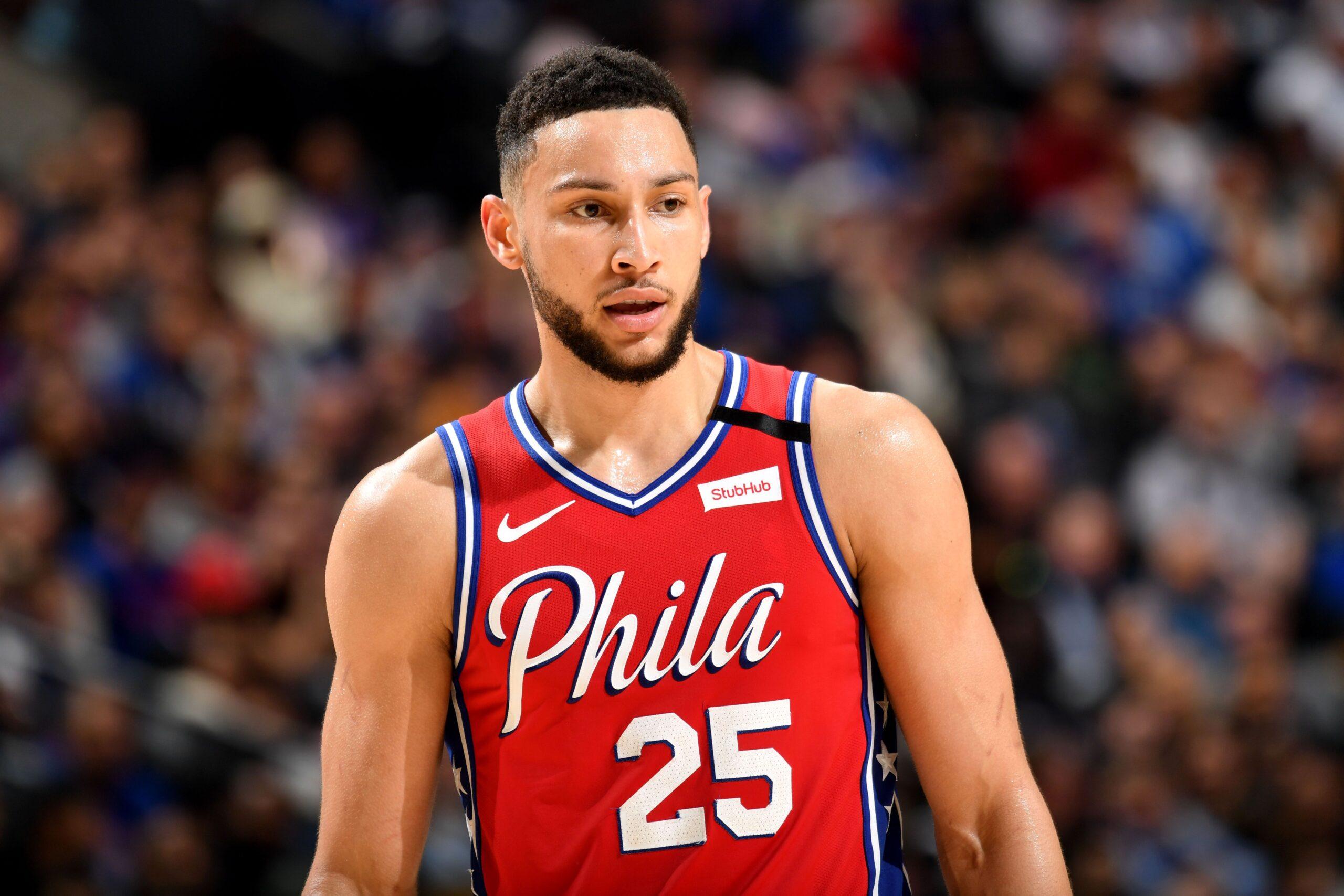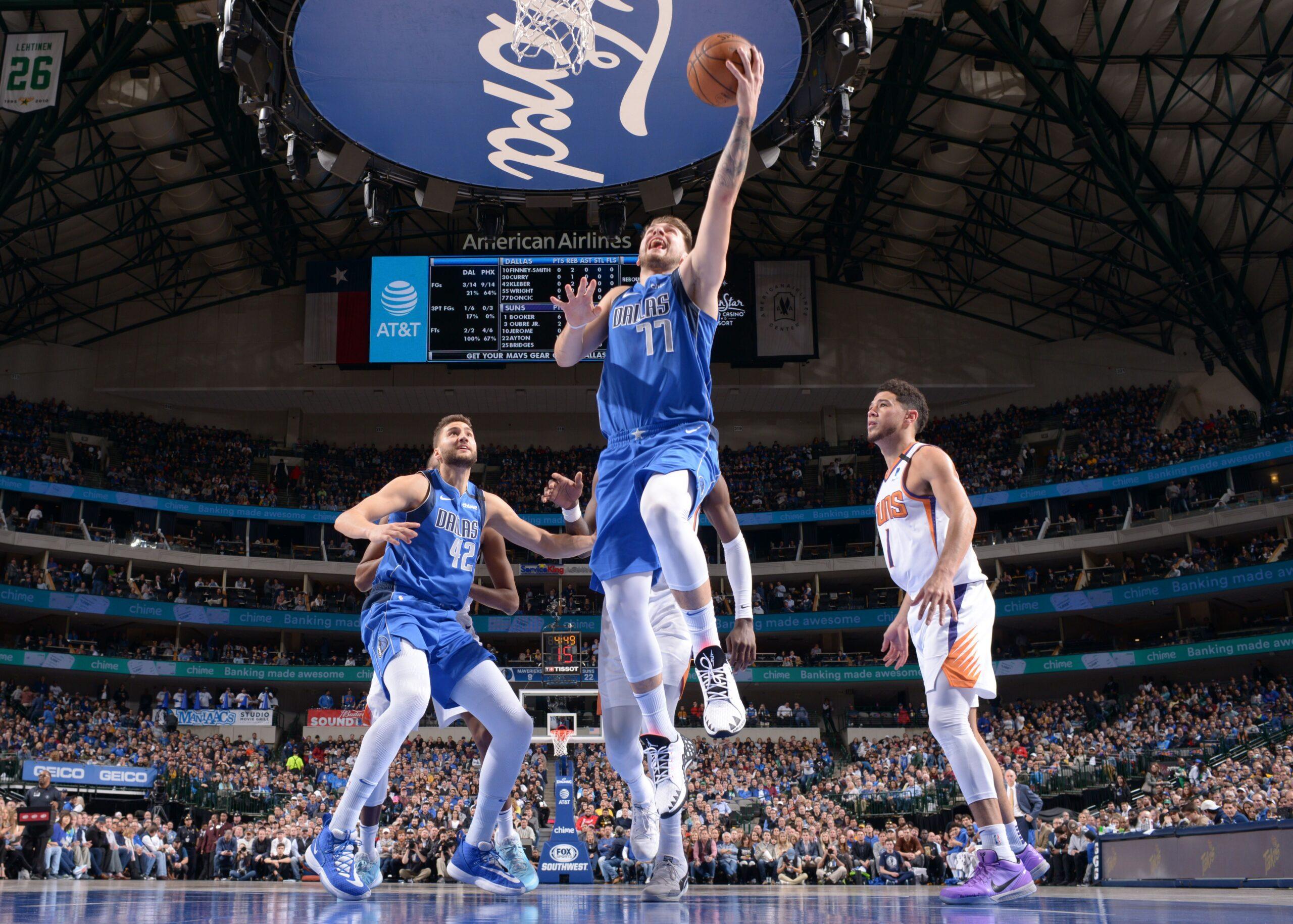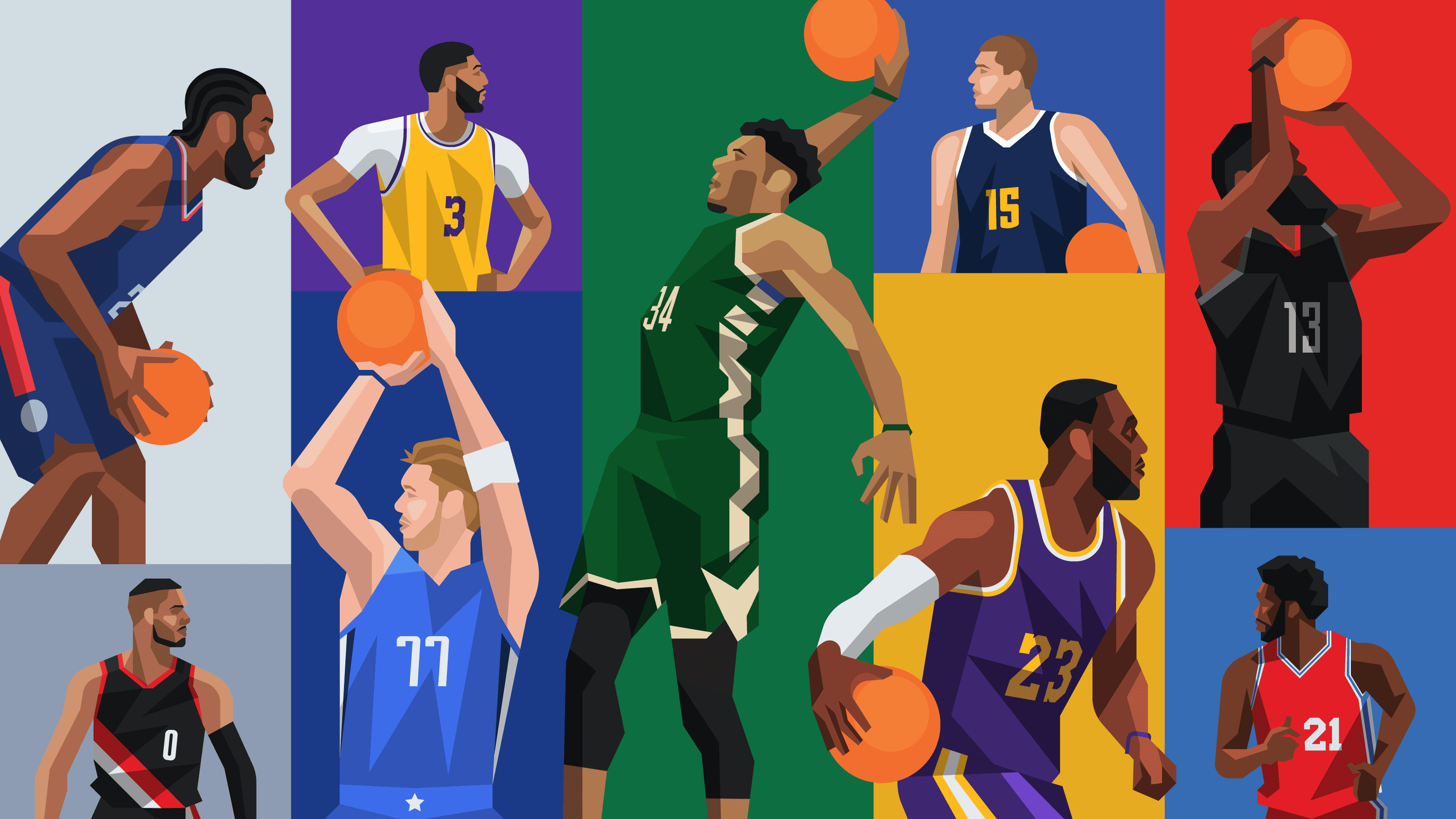The Top 25 NBA Players of the First 55ish Games
A modest ranking of the best in the league heading into the final stretch of the 2019-20 NBA seasonEvery team is either at or around 55 games played in the 2019-20 NBA season, which means it’s time to rank once again. Just like in December, after 25ish games played, The Ringer’s NBA staff was asked to rank the 25 best players in the league based solely off of what’s happened so far this season. The full results, based on average ranking, are as follows.
T-25. Kyle Lowry, Raptors
Position: Guard | Previously: NR
19.6 points, 7.6 assists, 4.7 rebounds, 1.2 steals, 52.0 eFG%, 5.3 net rating, 43 GP
Justin Verrier: All credit is due to the Raptors’ developmental pipeline, which has suddenly become basketball’s answer to Moneyball, but Toronto doesn’t go into the All-Star break with the NBA’s third-best record without its old head leading the way. Virtually every key rotation player from last year’s championship run has gone on the shelf, but since returning from his own 11-game absence in early December, Lowry has been the bedrock of the Raptors’ success as they lean on an undrafted rookie here, a reclamation project there. Lowry’s averages are never ostentatious, but his fungibility is remarkable. When the Raps traded for Kawhi Leonard, Lowry scaled back on the usage and shifted into distributor mode, finishing last season averaging a career-high 8.7 assists; this season, as weapons like Pascal Siakam, Fred VanVleet, etc., hit the decks, Lowry is scoring at the third-highest rate of his career. And through it all, the team defense has remained elite. Siakam may be the team’s superstar, but Lowry is the team’s ethos incarnate.
T-25. Domantas Sabonis, Pacers
Position: Big | Previously: NR
18.3 points, 4.8 assists, 12.5 rebounds, 0.5 blocks, 55.0 eFG%, 4.0 net rating, 52 GP
Zach Kram: Here are the league leaders in points created for teammates, combining traditional assists and screen assists:
- Nikola Jokic (30.0 points per 36 minutes)
- Domantas Sabonis (29.3)
- LeBron James (29.1)
It’s difficult to overstate Sabonis’s leap this season, with the Pacers big melding increased workload, increased responsibility, and increased productivity into one enviable package. He scores and rebounds and creates for others; he’s well worth his first All-Star spot.
24. Donovan Mitchell, Jazz
Position: Guard | Previously: 20
24.3 points, 4.3 assists, 4.3 rebounds, 1.1 steals, 51.9 eFG%, 4.8 net rating, 53 GP
Paolo Uggetti: In his third season, Mitchell has improved in nearly every statistical category. He’s more efficient in virtually every way, and he has the Jazz on a 54-win pace. Sure, the Dwyane Wade comparisons may have been a bit premature, but Mitchell has star power, full stop. Is it enough to lift Utah to more than just impressive regular seasons? That will likely require an even bigger leap than we’ve seen so far. The Jazz have hung around the fringes of contention for a few seasons now, and though the Mike Conley addition was thought to have put them in the upper echelon, that push will probably have to come from Mitchell. Utah’s anchor may be Rudy Gobert, but Mitchell is its rocket ship.
23. Paul George, Clippers
Position: Wing | Previously: 15
21.7 points, 3.9 assists, 6.1 rebounds, 1.3 steals, 52.4 eFG%, 7.4 net rating, 34 GP
Haley O’Shaughnessy: The combination of George and Kawhi Leonard seemed like it would make the Clippers unstoppable. But being dominant together requires being together; so far, George and Leonard have played alongside each other in 24 of the Clippers’ 55 games—a total of just 572 minutes—because of respective health issues. For George, the problem isn’t going away. On Thursday, he reaggravated the same hamstring that contributed to his being sidelined for 19 games already this season. When George is on the court, his role with the Clippers changes night to night. One version of 2019-20 George takes more than 10 shots from the perimeter. Another focuses on setting up the talent around him. This roster and Doc Rivers have meant freedom for George. He no longer has to be the adult in the room, just one of many. George still has the potential to be unstoppable, if his body will allow it.
22. Bam Adebayo, Heat
Position: Big | Previously: 24
15.8 points, 4.9 assists, 10.4 rebounds, 1.2 blocks, 58.0 eFG%, 4.4 net rating, 54 GP
Matt Dollinger: There’s no higher praise from Pat Riley than what he said Bam Adebayo means to the Heat: “He’s the Zo [Alonzo Mourning]. He’s the UD [Udonis Haslem]. He’s the Dwyane [Wade]. They were standard-bearers. Bam is that person. He is the real deal.” It’s no mistake that the Heat president paid that compliment to Adebayo and not his fellow All-Star teammate and Miami’s leading scorer, Jimmy Butler. That’s no knock on Butler. For all the grit and production Butler brings on both ends of the floor, there’s just no substitute for the transcendent talents of the 22-year-old big man developing in front of our eyes. Match his ability with a Riley-like passion for winning and improving and you’ve got one of the most valuable players in the league. It’s unclear just how high Adebayo’s ceiling stretches, but right now he projects as something like a Point Forward Ben Wallace, which should send shivers down the rest of the Eastern Conference’s back. He’s one of two players averaging at least one block, one steal, and double-digit rebounds per game, and his ability to run the floor and play above the rim has made him into one of the scariest players in the league.
21. Chris Paul, Thunder
Position: Guard | Previously: NR
17.4 points, 6.7 assists, 5.0 rebounds, 1.6 steals, 54.9 eFG%, 6.5 net rating, 54 GP
Dan Devine: We thought Paul had trapped himself. As it turns out, he’s looked more free in Oklahoma City than he has in years.
Long one of the NBA’s most domineering half-court taskmasters, Paul’s average time of possession per game is lower this season than it was in any of the six previous campaigns for which NBA.com keeps that data; playing alongside Shai Gilgeous-Alexander and Dennis Schröder, he’s more frequently sharing the ball, trading sole ownership of playmaking duties (he’s posting the lowest assist percentage of his career) for a larger share of responsibility as a finisher. After two seasons in Houston’s “avoid the midrange, it is hot lava” offensive scheme, CP3 is back to probing and meandering his way to the elbows, and back to carving up defenses with precisely the shots that so many of them want to give up. Fifty-seven percent of his shots come from the area between the rim and the arc, and he’s drilling a career-high 53 percent of them. He’s been the most productive closer in the league this season, scoring 128 points in 140 “clutch” minutes, shooting a scorching 54.5 percent from the field when the score is within five points in the final five minutes.
Paul isn’t the only reason the Thunder have a league-best 24 wins in close-and-late games, and have turned what looked like a bridge year into a surprising source of joy in OKC and an all-but-certain playoff appearance. He is the biggest one, though, which earned him his first All-Star selection in four years, and his 10th overall. Not a bad way to spend a year in limbo.

20. Bradley Beal, Wizards
Position: Guard | Previously: 13
29.1 points, 6.2 assists, 4.4 rebounds, 1.0 steals, 51.2 eFG%, minus-4.9 net rating, 46 GP
Uggetti: I don’t blame Beal, his fiancée, and his agent for voicing their displeasure over him not making the All-Star Game (even if you can make an easy case—defense, team performance—for leaving him out). First of all, the content was entertaining as hell. Second of all, Beal is out here churning out a career-high 29.1 points and 6.2 assists a game for a team with little talent and 20 wins this season. While the Wizards are somehow only three and a half games behind the Magic for the 8-seed, individual recognition is all Beal has left. If he does somehow lead Wizards into the playoffs with that roster, Beal might deserve a Nobel Prize.
19. Jayson Tatum, Celtics
Position: Wing | Previously: 23
22.4 points, 2.9 assists, 6.9 rebounds, 1.4 steals, 51.5 eFG%, 11.2 net rating, 50 GP
Verrier: I’m still trying to figure out how Tatum finished behind Kemba Walker. Because as well as Kemba has played this season, and as good as Kemba has been at not being Kyrie Irving, he hasn’t come close to the two-way impact of his young, mutton-chopped running mate. Though, to be fair, neither has anyone else in Boston: The Celtics are at their best when Tatum is on the floor, and at their worst when Tatum is off the floor.
The not-yet-22-year-old has taken a leap this season, leveraging the extra ball movement, spacing, and opportunities into career highs virtually across the board. But the biggest jump has been in Tatum’s confidence: He’s driving the ball nearly twice as often, and he’s already taken almost as many shots within 5 feet as he did all of last season. And he’s only getting better the more he realizes how good he is. Sharing the court with three others on this list in Thursday’s double-overtime win against the Clippers, Tatum proved to be the biggest swinging wing: He had 39 points and nine rebounds, and, per ESPN, held Kawhi Leonard to 3-for-11 shooting—including 1-for-7 in the fourth quarter and the two OTs. Kemba called him the best player on the court. If he starts drawing more fouls, he could be one of the very best players in the league by the end of this season.
18. Devin Booker, Suns
Position: Guard | Previously: 14
26.4 points, 6.3 assists, 4.2 rebounds, 0.8 steals, 55.1 eFG%, 2.1 net rating, 52 GP
Jonathan Tjarks: Booker started in the NBA with shooting talent. He has added something to his game in each of his five seasons. His latest jump is in efficiency. Booker is shooting 49.7 percent from the field, after shooting 43.6 percent in his first four seasons. One of the surest signs of greatness is the ability to keep getting better. Booker has grown by leaps and bounds since his rookie season by staying in the gym and working on his craft. There’s no reason to think he will stop now. He’s making his first All-Star appearance at the age of 23. It may be a long time before he misses another one.
17. Trae Young, Hawks
Position: Guard | Previously: 16
29.7 points, 9.2 assists, 4.4 rebounds, 1.2 steals, 52.7 eFG%, minus-5.8 net rating, 50 GP
O’Shaughnessy: As brilliant as Young has been, there’s still an impulse to put an asterisk next to his season of thrills. He received the most All-Star votes for guards in the East, but he came in third in player voting. He’s the league’s third-leading scorer in 2019-20, but he’s on the Hawks, where he’s encouraged to shoot his heart out. (Young is averaging 20.7 shots per game, with more total field goal attempts than Bradley Beal, Giannis Antetokounmpo, LeBron James, Devin Booker, and Russell Westbrook.) He’s the leader Atlanta tanked for, but its 15-41 record is the third worst overall. Though accepting those caveats doesn’t mean rejecting Young’s importance. After the disclaimers, Young is still Young—his 3s fall from behind the arc and infinity and beyond, his creative passing is now considered one of the arts, his handles are a freestyle on a beat he stops and starts as he pleases. Young is 21, but he’s already one of the league’s best players.
16. Karl-Anthony Towns, Timberwolves
Position: Big | Previously: 7
26.5 points, 4.4 assists, 10.8 rebounds, 1.2 blocks, 60.0 eFG%, minus-1.5 net rating, 35 GP
Kram: No player dropped more from our December list than Towns, who in the intervening span missed a month of games and moped through the nights he was able to play.
Even at half-speed, Towns is a statistical monster offensively; he leads all high-usage players in true shooting percentage and should become the first player in league history to average 10 rebounds and three 3-pointers per game. Towns is effectively unguardable—but he might sacrifice almost as much on the other end. Minnesota scores 14.4 more points per 100 possessions with Towns on the court, but allows 11.1 more at the same time.
15. Khris Middleton, Bucks
Position: Wing | Previously: NR
20.4 points, 4.3 assists, 6.1 rebounds, 1.0 steals, 58.3 eFG%, 13.9 net rating, 47 GP
J. Kyle Mann: If Mike Budenholzer were to have sat down with the Bucks at midcourt of Fiserv Forum back in the summer to imagine the perfect lap, I’d say this season is close to what he would’ve envisioned. The synergy among Milwaukee’s personnel is so good that it’s lifting every player’s efficiency, but Middleton has been a critical, dynamic piece. He’s posting career-high marks in points, rebounds, assists, and true shooting percentage—and he’s doing it in the fewest minutes since his rookie season.
A big part of that is swimming next to an offensive great white shark like Giannis, but Giannis can’t make the shots for you. Middleton is killing it from everywhere, more or less, and he’s been one of the best spot-up players in the league as a result. He’s scoring 1.37 points per possession on those plays, up from 1.16 last season. I can already hear the quibbling over his place among other wings like Beal, Tatum, and Booker, but Middleton has been a fantastic plus-player on both sides of the ball for the best team in the NBA. He’s deserving.
14. Kemba Walker, Celtics
Position: Guard | Previously: 12
21.8 points, 5.0 assists, 4.1 rebounds, 1.0 steals, 53.0 eFG%, 7.8 net rating, 46 GP
Devine: Save for a frightening head/neck injury that thankfully turned out to look worse than it was and a couple of bouts of left knee soreness, the Celtics couldn’t have scripted a better first season in Boston for Walker. Surrounded by more shot-creating talent than he’s had in his career, Walker’s usage is down and his efficiency is up. He’s been a hand-in-glove fit in Brad Stevens’s offense—the C’s score 8.2 more points per 100 possessions with Walker on the court than when he sits—and has helped oversee a seamless transition from the brief Kyrie Irving era to a new structure in which perimeter players Tatum, Jaylen Brown, and Gordon Hayward can all operate as the tip of the spear and rotate as Boston’s brightest star on a game-to-game basis.
Given their superior size and contributions on the defensive end, you could make an argument that any of those swingmen are better overall ballplayers than Walker on any given night. (After Tatum scored 39 points and outplayed Kawhi Leonard in a thrilling double-overtime win against the Clippers just before the All-Star break, Walker himself called the 21-year-old “the best player on the court tonight.”) In the rush to praise Boston’s armada of wings, though, let’s not damn Kemba with faint praise. His work as a high-volume flamethrower and a megawatt-smiling vibes captain isn’t the only explanation for why everything’s clicking for a Celtics team that ranks in the top five in offensive and defensive efficiency and sits just 1.5 games behind Toronto for second place in the East. It sure as hell hasn’t hurt, though.

13. Ben Simmons, 76ers
Position: Guard (?) | Previously: 17
16.9 points, 8.3 assists, 7.9 rebounds, 2.2 steals, 58.5 eFG%, 2.3 net rating, 53 GP
Shaker Samman: There was a moment in Philadelphia’s mid-February win against the Clippers when everything surrounding Simmons seemed to crystalize. With the lion’s share of eyes focused on his outspoken teammate Joel Embiid, Simmons showed his true value. While Embiid sat, the Sixers offense came alive. Passing was crisp, movement was fluid, and the pace was breakneck. And it all came out of the 23-year-old Aussie. At his best, Simmons is one of the top two-way players in the game, mixing incredible driving and finishing ability with smothering defense and impressive size and athleticism. Philly’s versatile wunderkind is the skeleton key to the Eastern Conference. If things are clicking, there’s no telling how far the 76ers will go this summer. There might not be a more frightful sight for defenders since Peak LeBron than Simmons this season. Call him a coward if you want; he doesn’t need to shoot 3s to beat his man.
12. Joel Embiid, 76ers
Position: Big | Previously: 11
22.9 points, 3.2 assists, 11.9 rebounds, 1.4 blocks, 50.7 eFG%, 4.3 net rating, 39 GP
Rob Mahoney: By no means does Embiid have to be perfect to be great. Some players can be frustrating and still dominant, off their game and still somehow in the pocket. There are plays every night that Embiid (and his coaches) would surely want back: questionable shots, careless turnovers, and lethargic efforts. There are simply far, far more that swing wildly in Philly’s favor with Embiid’s involvement. Beneath the exceptional production (starting with point and rebound totals matched only by likely MVP Giannis Antetokounmpo), Embiid dictates the way a game is played. The lineups that opponents put on the floor, the lengths they’ll go to steer around the threat of his shot blocking, the shades and doubles and constant attention—all of it comes back to Embiid, because to give him anything less than your full attention is likely to get you rocked. Underestimate him at your own peril.
11. Rudy Gobert, Jazz
Position: Big | Previously: 19
15.6 points, 1.5 assists, 14.6 rebounds, 1.9 blocks, 68.9 eFG%, 9.0 net rating, 52 GP
Dollinger: After stumbling out of the gate, the Jazz have hit their stride in the second quarter of the season, notching the most wins (36) in franchise history before the All-Star break. As my colleague Paolo Uggetti predicted in December: “It’s a long season, and once (if?) the Jazz settle in, Gobert will be a big reason for their success.” He was right. Gobert is anchoring Utah (just 1.5 games behind the West’s no. 2 seed) on both ends of the floor, doing what he does best: protecting and finishing at the rim at staggeringly efficient rates. While the two-time reigning Defensive Player of the Year is best known for his efforts on that end of the floor, his impact on the Jazz’s offense can’t be overstated, with the team averaging 8.8 more points per 100 possessions when he’s on the court—an even bigger variance than his effect on the defense. The notoriety around the league has also increased for the oft-overlooked Frenchman. He jumped eight spots from our previous rankings, was picked ahead of flashy players like Russell Westbrook, Jayson Tatum, and teammate Donovan Mitchell in the All-Star draft, and got away with the biggest goaltend of the season. Now that’s true superstar treatment.
10. Pascal Siakam, Raptors
Position: Big wing | Previously: 9
23.5 points, 3.5 assists, 7.5 rebounds, 1.0 steals, 51.3 eFG%, 8.9 net rating, 44 GP
Samman: If imitation is the finest form of flattery, then Siakam must spend most of his days blushing. Just as teams set out to find the next Draymond Green after Golden State’s do-it-all forward emerged a few seasons ago, franchises across the league have spent the past year scouting for the next Pascal. In another life, they’d be cast off as “tweeners.” Now they’re one of the league’s most desirable archetypes. Detroit could have one in Sekou Doumbouya. The Grizzlies could have theirs in Brandon Clarke. But neither skilled big man holds a candle to the original. Siakam won Most Improved last season, and in a just world would win it again this season. The fourth-year forward isn’t just an All-Star; he’s a damn near superstar. The Raptors lost one of the best players alive and another starter after winning the title last June, and thanks to Siakam still have the third-best record in the NBA. The 25-year-old Cameroonian is already an All-Star and a champion. Now he’s one of the top basketball players in the world.
9. Jimmy Butler, Heat
Position: Wing | Previously: 8
20.6 points, 6.1 assists, 6.8 rebounds, 1.8 steals, 47.9 eFG%, 5.6 net rating, 46 GP
Verrier: Butler’s drill sergeant routine grew tiresome in Minnesota and Philadelphia, but his play in Miami has earned him the ultimate compliment: He gets to be as much of an asshole as he wants. In between bating his old team and pissing off most of the league, Butler has easily been one of the 10 best players in the NBA this season. Butler and Miami have been great for each other: The Heat have adopted his take-no-shit personality and snarly, switchy game, and his all-around performance has hit a new level (career highs in rebounds, assists, and free throws attempted) in a system that maximizes the best in players whose skill sets often contradict their measurements. Butler’s previous gripes about wanting his own shop felt unearned, given his All-Star-but-not-All-NBA-First-Team production. But he called his shot and, with Miami, he’s backed it up. Respect.
8. Nikola Jokic, Nuggets
Position: Big | Previously: 18
20.6 points, 6.9 assists, 10.2 rebounds, 0.7 blocks, 55.8 eFG%, 5.6 net rating, 55 GP
Mann: It’s hard to believe that Jokic is still only 24 years old. He and Steven Adams have this thing in common where I see them in their familiar uniform for the bazillionth time and think, “He’s been in the league since like 2010, right? Played with Carmelo right before the deal?” Nope. This is Year 5 for Jokic, and the unique well-roundedness of his offensive game continues to be one of the more remarkable things in basketball.
There have been only four seasons in which a player 6-foot-10 or taller has averaged at least 20 points, 10 rebounds, and 6.5 assists. Jokic owns two of them (including one this season), and Wilt Chamberlain owns the other two. With those numbers in mind, ponder this: Jokic leads the league in touches at 98.9 per game, averages 2.37 seconds per touch, and still maintains one of the highest assist-to-usage marks in the NBA. When he touches the ball, something good typically happens, and quickly.
The optics of his game are always going to make us wonder whether he’s in good enough shape or running hard enough, but it’s painfully clear that he’s the best passing center ever to play the sport. I’ll take it.
7. Damian Lillard, Trail Blazers
Position: Guard | Previously: 10
29.5 points, 7.9 assists, 4.4 rebounds, 1.0 steals, 55.6 eFG%, 0.9 net rating, 54 GP
Uggetti: When Lillard hurt his groin badly enough to keep him out of all All-Star Weekend festivities aside from his halftime rap performance, it didn’t come as a total surprise. Lillard has been carrying a huge burden. In a season filled with injuries, Portland has needed Lillard to go supernova, and he has done just that, averaging nearly 30 points and eight assists per game (both career highs) as well as a career-high 55.6 effective field goal percentage while attempting 10 (!) 3s a game. Lillard has, at his best, filled the Steph Curry–size void this NBA season. And while Dame hasn’t done it as long as Steph, he has grabbed our attention by torching teams lately: In his past 12 games, Lillard is averaging more than 37 points a game and had a run of 61, 47, and 50 points in three straight games. The Blazers, meanwhile, are praying the groin injury isn’t serious and hoping Dame can keep carrying them all the way to the playoffs.

6. Luka Doncic, Mavericks
Position: Guard | Previously: 4
28.9 points, 8.7 assists, 9.5 rebounds, 1.0 steals, 53.7 eFG%, 7.1 net rating, 44 GP
Tjarks: The scariest thing about Luka’s incredible sophomore campaign is how much room he still has to improve. He’s nearly averaging a 30-point triple-double while shooting only 32 percent from 3 and still figuring out how to incorporate his game with other ball handlers. Imagine how good he can be once he starts playing off his teammates and letting them create easy shots for him. Luka’s game is based on his combination of size and skill, which means that he shouldn’t peak until he’s in his late 20s. That’s almost a decade from now.
5. Kawhi Leonard, Clippers
Position: Wing | Previously: 6
27.2 points, 5.3 assists, 7.5 rebounds, 1.8 steals, 51.5 eFG%, 11.0 net rating, 42 GP
Dollinger: You fools. You’re all playing into Leonard’s enormous hands once again. While the rest of the NBA is fixated on Giannis, LeBron and AD, Luka, and the Rockets, the reigning NBA Finals MVP is averaging career highs in points, rebounds, and assists and boasts a higher net rating and usage percentage than he did in his title-winning season with the Raptors. And while the NBA’s Load Management King continues to steal rest (missing almost a fourth of his team’s games and averaging his fewest minutes in a full season since 2014-15), the Clippers are 31-10 in games he plays, giving them a .756 winning percentage that just barely trails the West-leading Lakers. In other words, Kawhi Leonard is as dangerous and fresh as ever. He’s more than happy to let his peers bask in the limelight during the regular season. Because come playoff time, Kawhi will likely transform into the NBA’s most dominant postseason force once again.
4. Anthony Davis, Lakers
Position: Big | Previously: 5
26.6 points, 3.3 assists, 9.2 rebounds, 2.4 blocks, 54.8 eFG%, 5.9 net rating, 46 GP
O’Shaughnessy: “We like where we are right now,” is how Davis explained the Lakers’ mind-set heading into the All-Star break. Davis, specifically, likes where he is right now: at the top of the West, next to a superstar, favored to win a title. Players sometimes shrink their games to fit next to another elite talent. With LeBron, it’s twice as likely. Yet Davis has expanded his, even though his field goal attempts have dropped a smidgen from his time with the Pelicans. Davis is still doing heavy lifting with the Lakers, leading the team in scoring, rebounding, and blocks by a mile, while also getting to the line far and away more often than his teammates. Maybe this is just the first time we’re seeing him set up for success.
3. James Harden, Rockets
Position: Guard | Previously: 2
35.3 points, 7.3 assists, 6.5 rebounds, 1.6 steals, 53.6 eFG%, 5.8 net rating, 51 GP
Devine: I was thinking about Harden recently, in the context of Russell Westbrook’s reinvention as something like a supercharged 6-foot-3 Ben Simmons and the Rockets’ recent drastic shift toward extreme small ball. Maybe they’re doing all this changing up, I thought, because they’re trying to figure out a way to stay afloat while Harden is struggling.
And he had been struggling, going through a 10-game cold snap during which he missed two-thirds of his field goal attempts and more than three-quarters of his 3-pointers. You know what that frigid streak did to his full-season numbers? It dropped them below his production from last season, all the way down to a truly pathetic and frankly embarrassing 37.1 points, 7.2 assists, and 6.2 rebounds per game.
“Struggles” are relative, I guess is my point.
They also don’t always last that long. Playing in the acres of wide-open space afforded in Houston’s center-less five-out attacks, Harden scored 40 or more three times in his last six games before the break, capped by a 42-point, eight-rebound, seven-assist effort in an impressive double-digit win over a very good Celtics team. He’s on pace to become just the eighth player in history to lead the league in scoring for three straight seasons, joining George Mikan, Neil Johnston, Wilt Chamberlain, Bob McAdoo, George Gervin, Michael Jordan, and Kevin Durant.
There’s a lot of skepticism about the Rockets—about whether Daryl Morey has gone all in with a bad hand by committing to Lilliputian lineups that won’t be able to defend or rebound well enough in a seven-game series; about whether Westbrook has truly turned over a new offensive leaf or if his old 3-jacking habit will rear its ugly head when the heat’s turned up in the postseason; and, most of all, about whether Harden will once again roll up monstrous regular-season numbers before running aground in the playoffs. While we wait to find out the answers, we’ll just have to content ourselves with watching one of the most singular and undeniable offensive machines in NBA history keep infuriating and bamboozling defender after defender after defender in the meantime. Again: Struggles are relative.
2. LeBron James, Lakers
Position: LeBron | Previously: 3
25.0 points, 10.8 assists, 7.8 rebounds, 1.3 steals, 54.4 eFG%, 10.9 net rating, 51 GP
Kram: The longer the season progresses, the more this comparative statistic seems less fluky, and more real:
LeBron James and Anthony Davis
When LeBron is on the floor, the Lakers play at a near-Bucks level. When he’s off, they get outscored, even when Davis plays.
LeBron is the center of L.A.’s gravity—touching the ball more than anyone in the league aside from Jokic and Simmons, tossing the most assists, and even registering as an elite defender by advanced stats that use on/off data. He’s the best player on the second-best team in the league, by record, so it’s fitting that he places second on this list to the best player on the best team.
1. Giannis Antetokounmpo, Bucks
Position: Unicorn | Previously: 1
30.0 points, 5.8 assists, 13.5 rebounds, 1.1 blocks, 58.7 eFG%, 14.6 net rating, 48 GP
Mahoney: What an unimpeachable season this has been for the Bucks, who, in case you had forgotten, are still very much on pace for the third-ever 70-win season. The reasons for this are many and layered. They also all wind back to something exceedingly simple: Antetokounmpo has the power to be the best player in every game he plays, and wields that power with genuinely awesome focus. No other superstar leaves so little to chance. Giannis doesn’t assume that a rebound will fall into the waiting hands of a teammate, that Milwaukee will get stops if he sticks to a role, or that a double-digit lead is safe enough to slow things down. He grabs it and transcends it and pushes it, to the harm of every other team. There is craft and subtlety to the way Giannis plays, but those things seem almost beside the point when entire games are played in his footprint.


